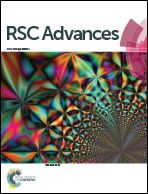Generation of reactive aryl radical intermediates in the reductive photodehalogenation of itraconazole†
Abstract
The photochemical properties of itraconazole (1), a broad-spectrum antifungal agent, have been investigated in connection with reported skin photosensitivity disorders. Steady state photolysis, fluorescence and phosphorescence experiments have been performed to understand photoreactivity of 1 in biological media. The drug is unstable under UVB irradiation, suffering a primary dehalogenation of the 2,4-dichlorophenyl moiety that occurs mainly at the ortho-position. In poorly H-donating solvents, such as acetonitrile, the major photoproduct arises from intramolecular attack of the initially generated aryl radical towards the triazole ring. In addition, reduced compounds resulting from homolytic cleavage of the C–Cl bond in ortho or para positions and subsequent H-abstraction from the medium are obtained to a lesser extent. In good H-donating solvents, such as ethanol, the main photoproducts are formed by reductive dehalogenation. Furthermore, irradiation of a model dyad containing a tryptophan unit and the reactive 2,4-dichlorophenyl moiety of itraconazole leads to formation of a new covalent link between these two substructures revealing that homolysis of the C–Cl bond of 1 can result in alkylation of reactive amino acid residues of proteins, leading to formation of covalent photoadducts. Therefore, it has been established that the key process in the photosensitization by itraconazole is cleavage of the carbon–halogen bond, which leads to aryl radicals and chlorine atoms. These highly reactive species might be responsible for extensive free radical-mediated biological damage, including lipid peroxidation or photobinding to proteins.


 Please wait while we load your content...
Please wait while we load your content...